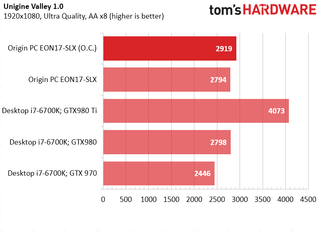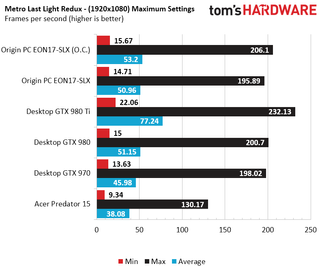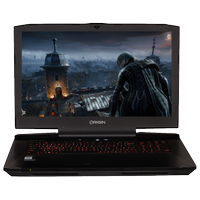Origin PC EON17-SLX Gaming Laptop First Look
The Origin PC EON17-SLX features a desktop-class Nvidia GeForce GTX 980 graphics module and Intel Core i7-6700K host processor. Let's see what it can do!
Benchmarks And Conclusion
We ran a combination of synthetic and gaming benchmarks to test the EON17-SLX, including PCMark 8, 3DMark Fire Strike (including Fire Strike Extreme and Ultra), Unigine Valley and GFXBench. Our game tests use the built-in benchmarks in Bioshock Infinite and Metro: Last Light Redux.
The EON17-SLX arrived overclocked from Origin PC, with its Core i7-6700K set to 4.5GHz and the GeForce GTX 980 bumped up 70MHz on the core and memory clocks. We tested the system at both overclocked and stock settings. We also left G-Sync off for these tests, unless otherwise noted.
To compare the EON17-SLX to the mid-range laptops in our lab would be pointless. Origin PC is a beast of a machine sporting desktop components, after all. So, in an effort to provide meaningful results, we tested a custom-built desktop PC with almost identical hardware specs at default clock rates and settings. We even swapped out the graphics card to compare performance to slightly lower- and higher-end configurations, using a reference GeForce GTX 980, and factory-overclocked GTX 980 Ti and GTX 970 boards. Here are the desktop test rig's specs:
| Operating System | Windows 10 Pro 64-Bit |
|---|---|
| Processor | Intel Core i7-6700K |
| Motherboard | Asus Maximus VIII Ranger |
| Memory | 16GB (2 x 8GB) G.SKILL DDR4-2133 |
| Storage | 512GB Samsung 950 Pro NVMe SSD |
| Graphics Cards Tested | EVGA GeForce GTX 980 Ti FTW 6GB GDDR5Nvidia GeForce GTX 980 (Reference) 4GB GDDR5Asus GeForce GTX 970 Strix 4GB GDDR5 |
| CPU Cooling | Corsair H75 Closed-Loop Liquid Cooler |
Although the desktop's specs are similar to the EON17-SLX, differences in the BIOS, the motherboard's base clock rate, storage interface, memory timings and thermal solution can all affect results.
Synthetic Benchmark – PCMark 8

The EON17-SLX easily outperforms the Acer Predator 15 and Gigabyte P37X v4, both out of the box and at stock clock speeds, proving that a comparison to more mobile-oriented hardware isn't exactly fair.
Compared to my desktop configurations, the overclocked EON17-SLX fares better than even the GTX 980 Ti-equipped setup in everything except the Creative test, where GPU power has a profound impact on performance. At stock settings, though, the EON17-SLX outruns the desktops in Futuremark's Home and Work test modules, regardless of graphics card. This could be due to differences in the system’s memory timings, BIOS or CPU tuning. The bottom line is that Origin's EON17-SLX does hold its own against high-end desktops.
Synthetic Benchmark – 3DMark Fire Strike



Gaming performance is likely important for anyone considering purchasing an EON17-SLX, so we're running Fire Strike Extreme and Fire Strike Ultra to really push the GPU to its limits.
At stock clock rates, the EON17-SLX is on par with the desktop GeForce GTX 980. However, Origin PC’s overclocked frequencies facilitate higher scores. The Physics result, in particular, enjoys a notable bump due to the CPU's significant tune. Once again, we're including results from our Acer and Gigabyte laptop samples, just to show the performance difference between a desktop replacement and mainstream gaming notebook.
Fire Strike Extreme and Ultra demonstrate much of the same, with the EON17-SLX's overclocked settings beating the desktop rig with a reference GeForce GTX 980. Its Physics score also reigns thanks to an aggressive CPU overclock.
Of course, the desktop GTX 980 Ti outperforms the EON17-SLX's GTX 980. Still, it's interesting to see how the very best in mobile hardware compares to a desktop with one top-of-the-line GPU.
Synthetic Benchmark – GFXBench

The built-in battery test in GFXBench 4.0 gives the EON17-SLX's eight-cell battery an estimated run time of 130.8 minutes, or about 50 minutes less than Origin PC's estimate. We did test the laptop at maximum brightness though, and saw incredible average frame rates. Given that much performance and power consumption, roughly 130 minutes sounds reasonable. We weren’t able to test the laptop on battery power while it was overclocked; instead, we tested at default clock rates.
Synthetic Benchmark – Unigine Valley

At stock settings, the EON17-SLX falls within four points of the desktop Core i7-6700K and GeForce GTX 980 setup. Overclocked, the EON17 improved its score by over 100 points. As expected, the GTX 980 Ti-equipped desktop takes the lead in this test, though Origin's EON17-SLX puts up an impressive score.
Gaming Benchmark – Bioshock Infinite





The EON17-SLX performs on par with with the desktop system when we analyze the average and peak frame rates, but it also achieves consistently better minimums, too. Only the GeForce GTX 980 Ti fares better. Again, this could be attributable to nuances in the firmware, base clock rate or memory timings. What's clear is that the EON17-SLX keeps up with a similarly-equipped desktop quite well, and that it performs well ahead of standard gaming laptops.
Gaming Benchmark – Metro: Last Light Redux

Metro: Last Light Redux has a built-in benchmark that taxes the GPU heavily, and it’s no surprise the EON17-SLX performs on par with the desktop Core i7-6700K and GTX 980 combo. It also predictably beats the desktop GTX 970 and Acer Predator 15.
I took a moment to actually play the game to see if the obvious screen tearing I witnessed from the benchmark with v-sync disabled was noticeable during game play. It was, but enabling G-Sync rectified the issue immediately. With average frame rates below 60 FPS, the added value of a G-Sync display pays off with a better experience when playing Metro: Last Light Redux.
Conclusion
Origin PC's EON17-SLX is a laptop in the technical sense, but it competes against desktop configurations and leaves other high-end laptops in the dust. It's almost unfair to compare this desktop replacement to notebooks sporting mobile CPUs and GPUs.
As a consequence, though, the EON17 isn't going to be comfortable in your lap. Its considerable weight, large size and abundance of vents (with corresponding heat output) makes this machines better suited to a tabletop. At best, it's one heck of a portable machine for LAN parties.
The configuration Origin PC sent us will set you back $3,382. For that price, you get excellent build quality and premium performance with high-end desktop hardware and a G-Sync-capable display. It doesn’t feel right to call this thing a laptop, given its power, weight and size. You do get what you pay for though: some of the best mobile gaming performance currently possible.
MORE: All Laptops Articles
MORE: Laptops in the Forums
Derek Forrest is an Associate Contributing Writer for Tom’s Hardware and Tom’s IT Pro. Follow Derek Forrest on Twitter. Follow us on Facebook, Google+, RSS, Twitter and YouTube.
Stay on the Cutting Edge
Join the experts who read Tom's Hardware for the inside track on enthusiast PC tech news — and have for over 25 years. We'll send breaking news and in-depth reviews of CPUs, GPUs, AI, maker hardware and more straight to your inbox.
-
warezme It is more expensive than a small form factor box running a 980 without the built in keyboard screen of a laptop. It is aesthetically unattractive as a laptop but with desktop performance that makes it a hard sell to someone wanting a performance laptop. It is a niche product. I would rather have a Razer Blade with the 970m and small form factor mobo running a 980 than having to lug this around.Reply -
JamsCB Thanks for the write up. Very long time lurker, finally posting. When you start the reviews of gaming laptops, please include more portable options. I'm looking for a new gaming laptop now, but most articles I find for the "best gaming laptop" usually list the large "desktop replacement" style laptops. I'm a pilot, and on the road at least half the month, so I don't want something too big or heavy, yet I want one that is powerful. I'm also almost always near a plug if I'm actually gaming, so battery life while gaming isn't a huge concern. I'd appreciate it if you could include a few more reviews for the 15.6" and smaller, thin and light style of gaming laptops.Reply -
Au_equus IMO the biggest point is missing. FPS and synthetics are to verify that performance is in the same neighborhood. The desktop CPU/GPU is in a VSFF package, ie, temperature and noise should be the main highlights.Reply -
FritzEiv JamsCB: Thanks for this input. We're doing First Looks on a variety of laptops, including ones like you've described, but we're looking for what people eventually want more of. I suspect it's variety, and we'll try to look at all ranges and choices.Reply
Au_equus: We agree. These First Looks don't have that level of testing as noted in the top of the article, but we will be doing that in our reviews, so stay tuned. -
alphax45 This seems excessive and really niche. Here is my general response when someone says they are looking for a laptop: Why a laptop? Do you NEED it to be portable? IMHO a desktop will always be better in the price/performance area. I always ask people why do you think you need a laptop? Do you really need a portable full fledged computer or do you just want something more casual; a tablet for social and/or media consumption while you sit and watch TV along with a desktop for real computing may be better in many cases. YMMV/IMHO of course.Reply -
brettms71 Will these sort of laptops run an Oculus. Serious question, since the specs say it will, but oculus also states that what is also important is the direct connection to the video cards for throughput. I use gaming laptops, but also want to get into VR. So not sure if I need to move away from laptops for VR capabilities.Reply -
Golfis ReplyIt is more expensive than a small form factor box running a 980 without the built in keyboard screen of a laptop. It is aesthetically unattractive as a laptop but with desktop performance that makes it a hard sell to someone wanting a performance laptop. It is a niche product. I would rather have a Razer Blade with the 970m and small form factor mobo running a 980 than having to lug this around.
I thought the same thing. To my surprise at least when using amazon.de or .fr as a prizing reference, if you try to build a desktop pc that rivals an the 6700k and 980m sli performance, together with a backlit keyboard , a somewhat decent 2.1 speaker setup and the cheapest g-sync panel you can find, the actual price difference becomes almost non existent. -
gamebrigada For those that don't want to pay the OriginPC tax on outdated models should check this out...Reply
http://www.amazon.com/Prostar-P870DM-G-Display-i7-6700K-Wireless-N1535/dp/B017WN4YP4/ref=sr_1_5?ie=UTF8&qid=1455243412&sr=8-5&keywords=sager+P870DM-G
You can just search for that model for different specs. That's the newest in that same range from Clevo. For those wondering about warranty, Origin will not service it, they make you ship it to the Clevo repair center in California. -
alidan ReplyThis seems excessive and really niche. Here is my general response when someone says they are looking for a laptop: Why a laptop? Do you NEED it to be portable? IMHO a desktop will always be better in the price/performance area. I always ask people why do you think you need a laptop? Do you really need a portable full fledged computer or do you just want something more casual; a tablet for social and/or media consumption while you sit and watch TV along with a desktop for real computing may be better in many cases. YMMV/IMHO of course.
when my brother went to college, he refused to listen to me and got a laptop for around 1000$,
my reasoning for why not?
you are taking your full FAR better spec gaming pc to college, do ANY of your classes require a laptop to attend?
in a 2 years he may have classes that do, but nothing first year and probably nothing second year, so he got a 1000$ laptop now which could be completely outclassed in 2 years when he actually needs one because he is a moron.
most of my family moved to tablets for media consumption and light use, but once really work needs to be done they get on an ancient laptop and do it because it simply works better than a tablet does when real work is involved.
personally, i can see the fun in a laptop as a portable media box, emulation box, second pc for when mine is rendering and hitting 100% useage, and emergency backup but i can never bring myself to get one as they are just to expensive for what i get. -
TJ Hooker I bought a gaming laptop (Asus G75VX, not nearly as beastly as this one), during college. I went back to my parents' place for holidays and some weekends, and I wanted to be able to play games if I wanted while I was there. Plus I had something to bring with me to school when I occasionally needed to, although it was too big to be something you'd bring everyday and take notes in class with. Gaming laptop seemed like the best solution. After I graduated and moved away for good, I sold my laptop, built a desktop, and got a cheap tablet.Reply
I'm not saying that this Origin laptop (and, to some extent, gaming laptops in general) aren't a niche product, and don't usually offer the best value. But there are people for whom gaming laptops really are the best option. I just get annoyed when every article about gaming laptops seems to feature people questioning why anyone would buy one, and often implying that anyone who does did so out of ignorance. There's no need to point out that you can build a more powerful desktop for less money, most people are perfectly aware. Luckily the comments here don't seem to have quite reached that point yet.
That's not to say that some people buying gaming laptops aren't sometimes clueless people who don't seem to understand the concept of value for money. After I bought my G75VX I spent some time on the Asus forum for fellow ROG laptop owners, and I swear there was a new thread everyday with someone talking about RAID0-ing SSDs, or upgrading to 32 GB RAM (for a laptop used only for gaming and casual use).

